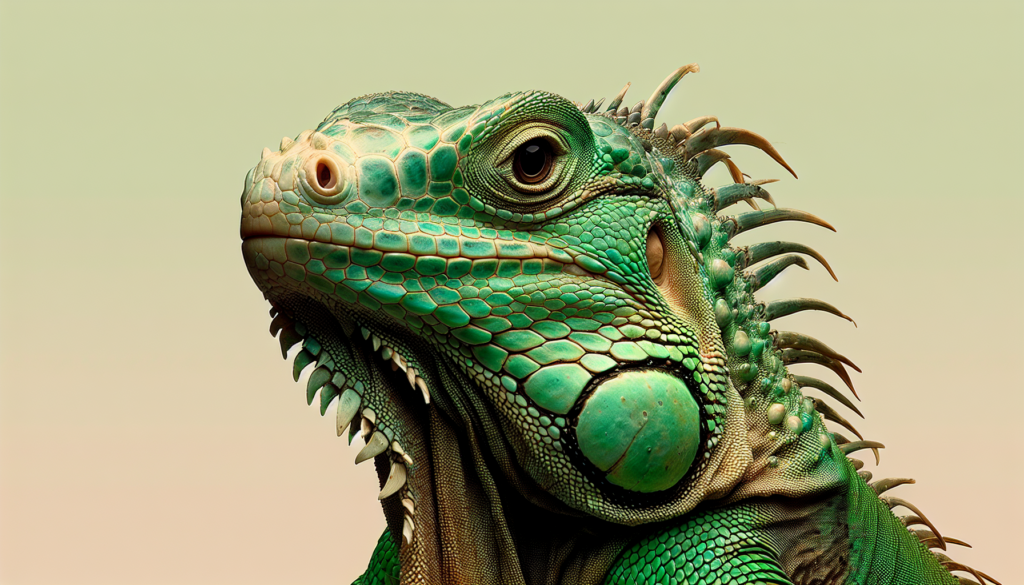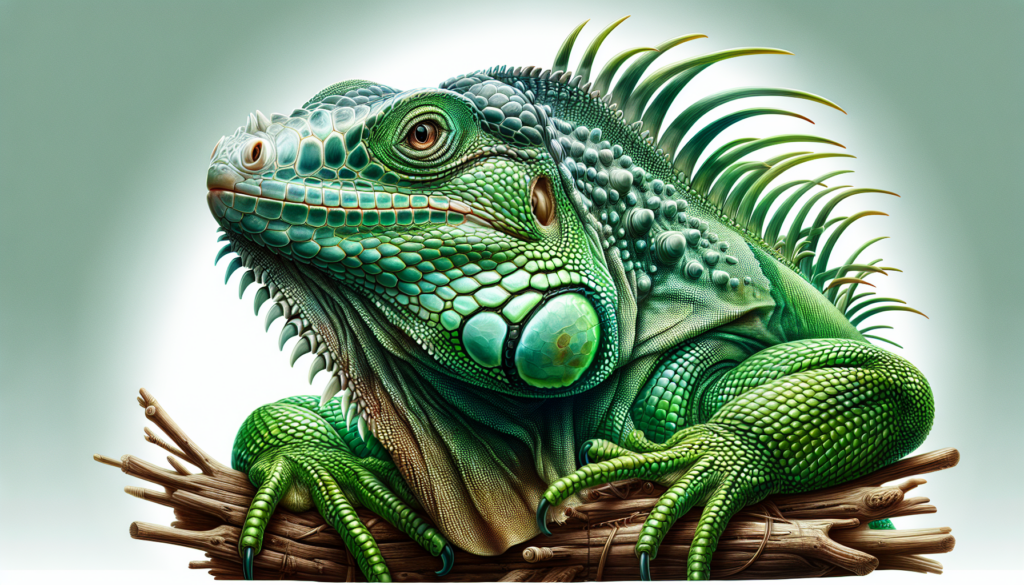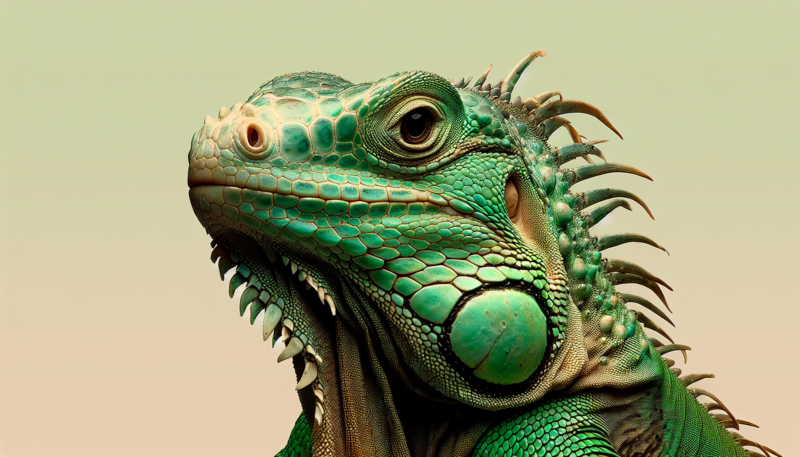Are you curious about the size of green iguanas? Look no further! In this comprehensive guide, we will explore the various factors that determine the size of these fascinating reptiles. From their initial size as hatchlings to their adult length and weight, we will delve into the world of green iguanas and provide you with all the essential information you need to know. Whether you’re a reptile enthusiast or simply intrigued by these majestic creatures, this guide is sure to satisfy your curiosity about the size of green iguanas.

Physical Characteristics of Green Iguanas
Green iguanas (Iguana iguana) are known for their impressive size and unique physical characteristics. Let’s explore the various aspects that define these magnificent creatures.
Size
Green iguanas are one of the largest lizard species in the world. Their size can vary, but on average, they can reach lengths between 4 to 6 feet (120 to 180 centimeters). It’s important to note that some individuals have been known to grow even longer, exceeding 6 feet (180 centimeters).
Weight
In addition to their length, green iguanas can also grow to be quite heavy. Adult iguanas typically weigh between 11 to 20 pounds (5 to 9 kilograms). However, some exceptionally large specimens have been recorded to surpass the 20-pound mark.
Body Shape
The body shape of green iguanas is uniquely designed for their arboreal lifestyle. They have a slender, elongated body with strong limbs and a long tail, which makes up a significant portion of their overall length. This body structure enables them to traverse tree branches with agility and grace.
Scalation
Green iguanas have distinctive scalation that plays a significant role in their overall appearance. The scales on their body are typically rough and keeled, providing them with a protective layer. These scales can vary in color from shades of green to brown, allowing the iguanas to blend seamlessly into their leafy surroundings.
Factors Affecting the Size of Green Iguanas
The size of green iguanas is influenced by various factors, including genetics, environmental conditions, nutrition, and overall health. Understanding these factors can help iguana owners provide the best care for their scaly companions.
Genetics
Just like humans, the size of green iguanas can be influenced by genetics. Some individuals may have genes that predispose them to grow larger or smaller than others. It’s important to remember that genetics alone do not determine the size of an iguana, as other factors play a significant role as well.
Environmental Conditions
The environment in which a green iguana lives can directly impact its growth. Optimal conditions, such as appropriate temperature, humidity, and access to sunlight, are crucial for their overall well-being and development. If the environment lacks these essential elements, it can hinder their growth potential.
Nutrition
Proper nutrition is vital for the healthy growth of green iguanas. A well-balanced diet rich in leafy greens, fruits, and vegetables is essential to meet their nutritional requirements. Inadequate or imbalanced diets can result in stunted growth or other health issues. Consulting with a veterinarian or reptile specialist can help ensure your iguana’s dietary needs are met.
Health
The overall health of a green iguana plays a vital role in its size. Regular veterinary check-ups, parasite control, and identifying and addressing any health issues promptly are essential for promoting optimal growth. A healthy iguana will likely reach its full growth potential compared to an individual suffering from health problems.
Size Comparison: Juveniles vs. Adults
Green iguanas undergo significant growth and development as they transition from juvenile to adult stages. Understanding the growth patterns and sexual dimorphism in these stages can provide valuable insights into their size differences.
Growth Pattern
Juvenile green iguanas tend to experience more rapid growth compared to adult iguanas. During their first year, they can grow up to 12 inches (30 centimeters) or more in length. As they continue to mature, their growth rate slows down, and they reach their full length in around four to five years.
Sexual Dimorphism
Sexual dimorphism refers to the physical differences between male and female green iguanas. In terms of size, males tend to be larger than females. While the exact size difference can vary, adult male iguanas can grow to be several inches longer and significantly heavier than their female counterparts.
Average Size of Male Green Iguanas
Male green iguanas exhibit larger dimensions compared to females. Let’s explore the average length and weight of adult male iguanas.
Length
Adult male green iguanas can reach an average length of 5 to 6 feet (150 to 180 centimeters). However, exceptional individuals have been recorded to grow even longer, exceeding 6 feet (180 centimeters). Their long tail contributes significantly to their overall length.
Weight
Male green iguanas are generally heavier than females. On average, adult males weigh between 15 to 20 pounds (7 to 9 kilograms). Their larger size and muscular build contribute to their increased weight compared to their female counterparts.

Average Size of Female Green Iguanas
Female green iguanas, although smaller in size compared to males, still grow to be impressive reptiles. Let’s explore the average length and weight of adult female iguanas.
Length
Adult female green iguanas typically reach a length of 4 to 5 feet (120 to 150 centimeters). While they might not grow as long as males, their sleek body shape and long tail still make them an impressive sight to behold.
Weight
Female green iguanas have a relatively lighter build compared to males. On average, adult females weigh between 11 to 15 pounds (5 to 7 kilograms). Their weight is influenced by various factors, including genetics, nutrition, and overall health.
Variations in Size Among Subspecies
Green iguanas exist in various subspecies, each exhibiting unique characteristics, including variations in size. Let’s explore an overview of some green iguana subspecies and the size differences among them.
Overview of Green Iguana Subspecies
Green iguanas have several recognized subspecies, each native to different regions of their natural habitat. These subspecies include the common green iguana (Iguana iguana iguana), the Lesser Antillean iguana (Iguana iguana insularis), and the Jamaican iguana (Iguana iguana melanoderma), among others. Each subspecies has its own specific characteristics, including variations in size.
Size Differences
While the exact size differences among subspecies can vary, some general trends can be observed. For example, the common green iguana (Iguana iguana iguana) tends to be larger than other subspecies, with some individuals reaching lengths of up to 6 feet (180 centimeters) or more. On the other hand, subspecies such as the Lesser Antillean iguana (Iguana iguana insularis) are usually smaller, with adults averaging around 4 to 5 feet (120 to 150 centimeters) in length.
Largest Recorded Green Iguanas
Like any living species, green iguanas exhibit a range of sizes. Here, we delve into the records of the largest ever recorded green iguanas.
Length
The largest recorded green iguanas have been known to exceed 7 feet (210 centimeters) in length. These exceptional individuals showcase the incredible potential for growth that green iguanas possess.
Weight
The weight of the largest recorded green iguanas is equally impressive. Exceptionally large individuals can tip the scales at over 25 pounds (11 kilograms) or more, showcasing their robust build and extraordinary size.
Smallest Recorded Green Iguanas
While some green iguanas reach impressive sizes, there are also smaller individuals within the species. Explore the records of the smallest ever recorded green iguanas.
Length
The smallest recorded green iguanas can measure as little as 3 feet (90 centimeters) in length. These diminutive individuals highlight the variability of size within the species.
Weight
The weight of the smallest recorded green iguanas can be around 4 pounds (1.8 kilograms) or even less. These petite individuals serve as a reminder that not all green iguanas grow to immense sizes and that their size is influenced by various factors.
The Importance of Proper Husbandry for Growth
To ensure the healthy growth and development of green iguanas, proper husbandry practices are crucial. Let’s explore how enclosure size and layout, temperature and UVB lighting, diet and feeding, and healthcare all play significant roles in their growth.
Enclosure Size and Layout
Green iguanas require spacious enclosures to accommodate their large size and climbing habits. A minimum enclosure size for adult iguanas is typically around 8 feet (240 centimeters) in length, 4 feet (120 centimeters) in width, and 6 feet (180 centimeters) in height. The layout should include sturdy branches or platforms for climbing and basking, as well as hiding spots to provide enrichment and security.
Temperature and UVB Lighting
Proper temperature and UVB lighting are essential for the growth and overall health of green iguanas. Maintaining a basking spot temperature of around 95 to 100°F (35 to 38°C), along with cooler ambient temperatures of 75 to 85°F (24 to 29°C), helps regulate their metabolism and enables the absorption of calcium. Full-spectrum UVB lighting is necessary for vitamin D synthesis, which is crucial for bone growth.
Diet and Feeding
Green iguanas have specialized dietary needs to support their growth. Their diet should primarily consist of leafy greens, such as collard greens, mustard greens, and dandelion greens. Fruits and vegetables can also be offered in moderation. It’s important to avoid feeding them animal proteins, as these can lead to health problems. Proper supplementation with calcium and vitamin D3 is crucial to support their bone development.
Healthcare
Regular veterinary check-ups are vital to monitor the growth and overall health of green iguanas. Preventative care, parasite control, and prompt treatment of any illnesses or infections are essential to ensure optimal growth. Consulting with a reptile veterinarian and following their recommendations regarding vaccinations, deworming, and other preventive measures will contribute to the healthy growth of your green iguana.
FAQs about the Size of Green Iguanas
To address some common questions and concerns, here are answers to frequently asked questions about the size of green iguanas.
How fast do green iguanas grow?
Green iguanas experience rapid growth during their first year of life, often reaching lengths of around 12 inches (30 centimeters) or more. However, their growth rate slows down as they mature, and they reach their full length in approximately four to five years.
What should I do if my green iguana is not growing?
If you notice that your green iguana is not growing as expected, it’s important to consult with a reptile veterinarian. Various factors, such as improper nutrition, environmental conditions, or underlying health issues, can contribute to stunted growth. A professional can help identify the cause and provide guidance on how to address the issue.
Can I control the size of my green iguana?
While you cannot directly control the size of your green iguana, you can influence its growth through proper husbandry practices. Providing an appropriate enclosure size, maintaining optimal environmental conditions, and offering a well-balanced diet are key factors that can contribute to your iguana’s healthy growth.
How long do green iguanas live?
Green iguanas have the potential for a long lifespan, with some individuals living for 10 to 20 years or more in captivity. However, their lifespan can be influenced by various factors, including genetics, husbandry practices, and overall health.
Are larger green iguanas healthier than smaller ones?
Size alone is not an indicator of an iguana’s overall health. While larger green iguanas can have a robust build, smaller individuals can also be healthy and thrive if provided with proper care. Factors like nutrition, environmental conditions, and healthcare play significant roles in determining the overall health and well-being of a green iguana, regardless of its size. Maintaining proper husbandry practices is crucial for promoting the health of your scaly companion, regardless of its size.
